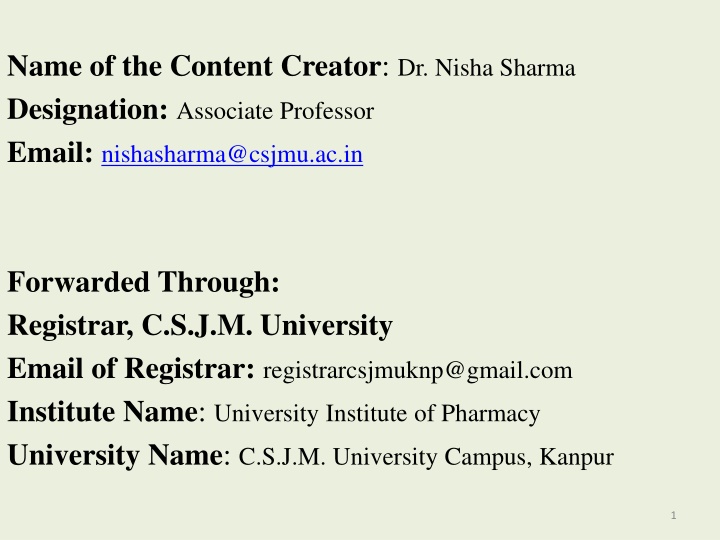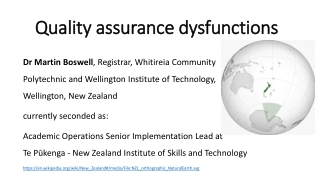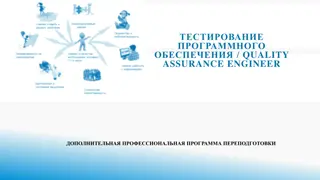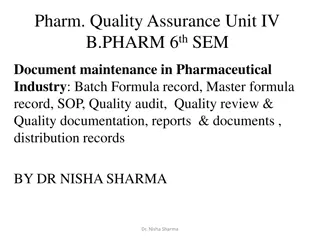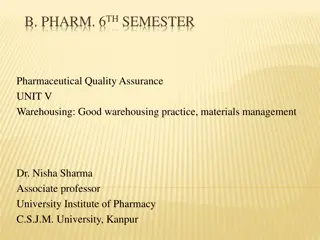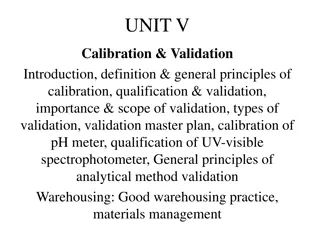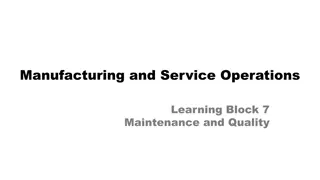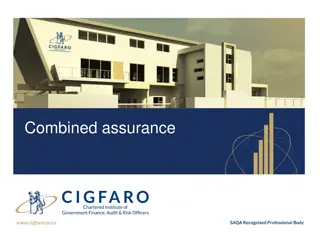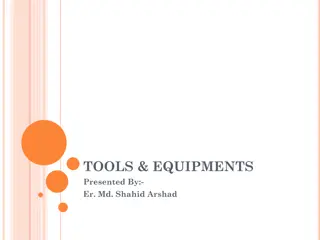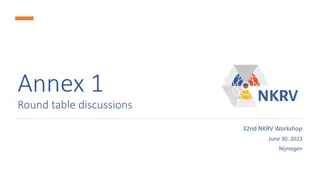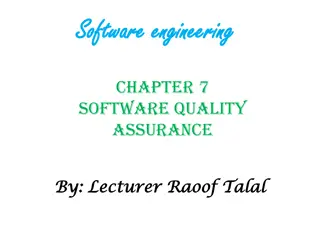Pharmaceutical Equipment Selection and Maintenance Guidelines for Quality Assurance
This content focuses on the selection, purchase specifications, and maintenance of equipment and raw materials in pharmaceutical quality assurance. It emphasizes the importance of well-defined selection procedures, strategic impact on business, and considerations for equipment design, size, and maintenance. The content also covers purchase specifications, safety requirements, and calibration practices for pharmaceutical equipment.
Download Presentation

Please find below an Image/Link to download the presentation.
The content on the website is provided AS IS for your information and personal use only. It may not be sold, licensed, or shared on other websites without obtaining consent from the author.If you encounter any issues during the download, it is possible that the publisher has removed the file from their server.
You are allowed to download the files provided on this website for personal or commercial use, subject to the condition that they are used lawfully. All files are the property of their respective owners.
The content on the website is provided AS IS for your information and personal use only. It may not be sold, licensed, or shared on other websites without obtaining consent from the author.
E N D
Presentation Transcript
Name of the Content Creator: Dr. Nisha Sharma Designation: Associate Professor Email: nishasharma@csjmu.ac.in Forwarded Through: Registrar, C.S.J.M. University Email of Registrar: registrarcsjmuknp@gmail.com Institute Name: University Institute of Pharmacy University Name: C.S.J.M. University Campus, Kanpur 1
B.PHARM. 6th Semester Pharmaceutical Quality Assurance Unit: 2 Equipments and Raw Materials Equipment Selection, Purchase specifications & Maintenance Purchase specifications and maintenance of stores for raw materials Dr. Nisha Sharma, Associate Professor 2
Equipment - Required for Mfg & many other operations - Can affect the quality of drug products - Selection procedure should be well defined & evaluated - Cleaning & maintenance procedure should be evaluated, validated, recorded 3
Selection & purchase specifications - Has strategic and financial impact on business Affects cost & quality of products, safety & environment of facility Factors for selection: 1. Operating criteria 2. Availability of spares & servicing 3. Maintenance 4. Environmental issues 5. Availability of design & maintenance manuals 6. Cost 4
Equipment design, size & maintenance Used in Mfg., Processing, packing, holding of drug product- Proper design, size & suitable location for intended use, easy cleaning, mainten. Design & operation manuals from suppliers for validation, qualification & maintenance is imp. Equipments construction: Surfaces in contact with drug/components should be inert-safety, identity, strength, quality, purity of drug Parts in direct contact should be autoclavable, washable Lubricating agents should not come in contact with drug products, containers, closures etc 5
Purchase specification of equipment: Specifications of equipments like size, weight, performance parameters, safety req. etc must be defined General considerations for purchase (Sch M): Equip., be located, designed, constructed, adapted & maintained to suit the operations Layout & design of equip., aims to minimize risk of errors, permit effective cleaning & maintenance, avoid cross contamination Log book of equipment Balances, other measuring devices proper range, accuracy, precision- in material stores, production, process control operations Should be calibrated periodically as per SOP 6
General considerations for purchase (Sch M): Parts coming in contact should not be reactive, additive, adsorptive so as to affect product Non toxic lubricants- to avoid accidental contamination Defective equipm, removed from production & quality control Washing and cleaning equipm should not be source of contamination 7
Cleaning Cleaning is removal of residues & contaminants from previous utilized equipment Inadequate cleaning- may result into malfunction or breakdown with adverse effects on products Cleaned, stored, sterilized, sanitized to prevent contamination as the case may be Methods of cleaning- documented, how, when, where of performing operation, personnel responsible, cleaning agents Cleanliness of most difficult areas, disassembly etc 8
Equipment cleaning procedure Sufficient details of cleaning each type of equipments Cleaning procedures: Details of assigned responsibilities Cleaning schedules with sanitizing schedules if Complete methods, materials, dilution of cleaning agents Instructions for disassembling & reassembling of equipments for cleaning Instructions for removal of previous batch identification Instructions for protection of clean equipments from contamination prior to use 9
Inspection of equipments for cleanliness immediately before use Written procedures for cleaning & its release for use Acceptance criteria for residues & choice of cleaning procedures & agents must be justified Equipment cleaning records: Records of cleaning for major equipments must be maintained Non major equipments: scoops, ladles, stirrers, spatulas cleaned properly Log books for each piece of equipment, not dedicated to manufacture of single product 10
Equipment cleaning records: Data of cleaning to be included in batch record for review Cleanliness status mentioned on it Annual review of equipment function must be carried Evaluation of Equipment cleaning : Areas to be covered Approved validation protocols Approved validation reports Equipment design & cleanability Defined & reproducible cleaning procedures for addressing difficult to clean areas Cleaning procedures must differ b/w batches of same products and b/w batches of different products 11
Time gaps between use & cleaning & b/w cleaning and reuse Operator training Sampling methods for cleaning of equipments - Swab Testing: extraction of swab with solvent & extractive is quantified - Extrapolation of amt. of residue obtained from swab to total surface area of equipment= total residue that can be transferred to next product - Important for areas that are hard to clean 12
- Solvent rinse: Cleaned equipment- rinsed with solvent in which residues are soluble - Level of resdiues calculated by the amount of solvent that is likely to be left in the equipment, which gets evaporated later - Advantage is: equipment parts difficult to reach like pipe work, valves - Placebo flush: - For solid dosage forms, its possible to flush equipments with placebo or excipient material like lactose. Test the placebo residues of previous product to get the required data 13
Evaluation of next product: Traces of previous product residues in the next product can also be done but less popular Visual Examination: Visual examination along with other recommended methods is required Acceptable residue limits: Calculation of levels for each material that is below range of therapeutic effect For highly potent compounds- limits are strict 14
Maintenance Written procedures for maintenance of equipments/ utensils Records: logs of individual equipments- date, time, product, lot no. etc. Important to reduce the breakdowns & to optimize the production cycle times. Poor maintenance : affects processing & quality of products May lead to lubricant leakage, wearing of components like bearings etc Space for equipment maintenance in plant layout Records of cleaning, maintenance, use, dated & signed by authorized person in chronological order CIP: Clean in place: cleaning of interior surfaces without dissembling SIP: Sterilize in place 15
Raw Material Substance used in production of intermediates or API API: Holds pharmacological activity Specification : List of references to analytical procedures & acceptance criteria having numerical limit, range or other criteria for test procedure. Material should meet as per given analytical procedures the listed acceptance criteria 16
Purchase Specifications 1. Name & code of reference material 2. Reference to pharmacopoeial monograph 3. Qualitative & quantitative requirements with acceptance limits 4. Name & address of supplier & original manufacturer of the material 5. Specimen copy of the printed material 6. Direction for sampling 7. Testing procedures 8. Storage conditions 9. Frequency for re assaying each starting material 17
Maintenance of Stores 1. Properly designed & adequate areas for warehousing of materials & products like: starting / packaging materials, intermediates, bulk, finished products, products in quarantine, rejected, returned, recalled or released products, machine, equipment spare parts/ accessaries 2. Warehousing areas: clean, dry, with temp. as/ limits 3. Should have house-keeping, provide procedures for rodents, pests, vermin. Pest control treatment regularly with proper records. 4. Racks, bins, platforms for storage of materials 18
Maintenance of Stores Receiving & dispatch bays protect materials & products from weather conditions Quarantine areas with proper demarcation & restricted Separate sampling areas in warehousing area for raw materials & excipients to prevent cross contamination Separate storage for rejected, recalled, returned materials, with marking Hazardous, toxic, explosive Materials should be stored in safe & secured areas Printed packaging materials stored in safe, separate, secured areas Separate dispensing areas for beta lactum, hormones, cytotoxic substances, with filtered air measures to avoid contamination by dust Sampling & dispensing of sterile materials in aseptic condition Regular monitoring : spillage, breakage, leakage of containers 19
REFERENCES Pharmaceutical Quality Assurance, Paul SD, Heswani G, Ed. 2019, S. Vikas and Company, Punjab. New Concepts in Pharmaceutical Quality Assurance, Chakraborty AK, Manekar SS, Rathod SM, Ed. 2020, S. Vikas and Company, Punjab. Pharmaceutical Quality Assurance, BP Nagori, A Gaur, R Solanki, V Mathur, 2018, Scientific Publishers Jodhpur.
